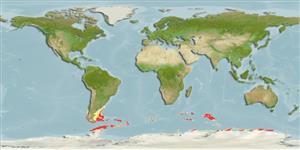Environment: milieu / climate zone / depth range / distribution range
Ökologie
seewasser demersal; tiefenbereich 100 - 1115 m (Ref. 5192). Temperate; 37°S - 67°S
Southern Ocean, South Atlantic, and South Indian Ocean. Argentine shelf/slope from 37°S to the Falklands and Burdwood Bank. Also Kotlyar; Crozet Islands and Prince Edward Island (Ref. 5000). Recorded from Chile (Ref. 27363).
Size / Gewicht / Alter
Maturity: Lm ? range ? - ? cm
Max length : 50.0 cm SL Männchen/unbestimmt; (Ref. 11892)
Rückenflossenstacheln (insgesamt) : 0; Rückenflossenweichstrahlen (insgesamt) : 112 - 129; Afterflossenstacheln: 0; Afterflossenweichstrahlen: 91 - 104. Pelvic fin on ocular side (with 7 soft rays) extremely larger than on blind side (with 5 soft rays). Caudal fin rounded (Ref. 27363).
Inhabit the lower continental shelves with surface-dwelling larvae and juveniles (Ref. 11892).
Life cycle and mating behavior
Maturities | Fortpflanzung | Spawnings | Egg(s) | Fecundities | Larven
Heemstra, P.C., 1990. Achiropsettidae. p. 408-413. In O. Gon and P.C. Heemstra (eds.) Fishes of the Southern Ocean. J.L.B. Smith Institute of Ichthyology, Grahamstown, South Africa. (Ref. 5000)
IUCN Rote Liste Status (Ref. 130435)
Bedrohung für Menschen
Harmless
Nutzung durch Menschen
Fischereien: kommerziell
Tools
Zusatzinformationen
Download XML
Internet Quellen
Estimates based on models
Preferred temperature (Ref.
123201): 1.4 - 5.8, mean 3.3 °C (based on 139 cells).
Phylogenetic diversity index (Ref.
82804): PD
50 = 1.0625 [Uniqueness, from 0.5 = low to 2.0 = high].
Bayesian length-weight: a=0.01995 (0.00906 - 0.04395), b=3.01 (2.83 - 3.19), in cm total length, based on all LWR estimates for this body shape (Ref.
93245).
Trophic level (Ref.
69278): 3.7 ±0.54 se; based on food items.
Widerstandsfähigkeit (Ref.
120179): mittel, Verdopplung der Population dauert 1,4 - 4,4 Jahre. (tm=2-3).
Fishing Vulnerability (Ref.
59153): Moderate vulnerability (44 of 100).
Climate Vulnerability (Ref.
125649): High to very high vulnerability (74 of 100).
Nutrients (Ref.
124155): Calcium = 35.3 [15.1, 57.1] mg/100g; Iron = 0.311 [0.153, 0.570] mg/100g; Protein = 18.7 [15.3, 22.4] %; Omega3 = 0.426 [0.222, 0.835] g/100g; Selenium = 23.4 [12.0, 48.1] μg/100g; VitaminA = 7.78 [1.84, 35.15] μg/100g; Zinc = 0.39 [0.27, 0.57] mg/100g (wet weight); based on
nutrient studies.
